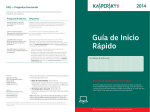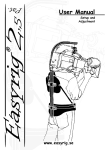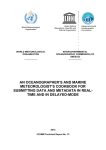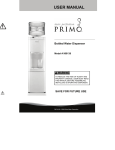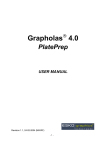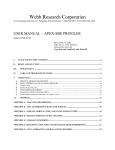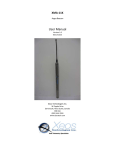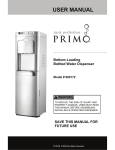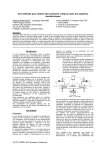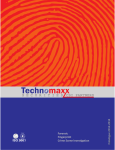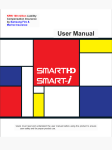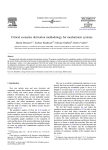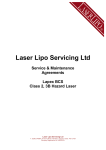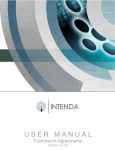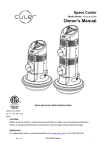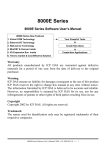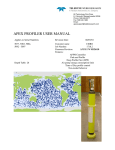Download Argos location at its best!
Transcript
Argos location at its best! CLS has developed a new location processing algorithm for Argos. The new technique continues to measure the Doppler frequency shift while introducing two significant additions: the integration of platform dynamics and the use of a Kalman filter to calculate positions. All Argos system users will now enjoy the following benefits: • More positions, • Better accuracy (an error estimate will be provided for all positions), • Automatic correction or elimination of all unrealistic positions. This new processing technique makes it possible to distribute up to 40% more positions and to improve accuracy by up to 65% while providing error estimates for each position, regardless of the number of messages received. These improvements are particularly significant for applications like animal tracking, where relatively few messages are received with each satellite pass. Red: GPS fixes Yellow: Argos locations using least squares analysis Green: Argos positions using Kalman filter special edition Oceanographers or biologists, satellite tracking just got better! #19 09/2010 Before ... Figure 1 (left) A drifting buoy tracked for 6 months. The GPS tracks are in red, the Argos positions from the current processing system are in yellow. ... After Figure 2 (right) In green, Argos positions are calculated using the new technique. These positions are much closer to GPS positions (in red). Unrealistic positions have been completely eliminated. 2 #19 09/2010 More positions, more accuracy… More positions: The processing system is now able to calculate positions using as few as one message per satellite pass. These positions are considered to be Class B. The median error for these positions varies between one and three kilometers, based on the platform type. The number of positions we are able to distribute increases primarily due to the inclusion of these one-message positions. Also, previously discarded positions are also now considered to be valid by the new processing system’s quality control. More accuracy: CLS measured positioning errors on several hundred Argos/GPS platforms, by comparing the Argos positions with the GPS fixes. For location classes 0,1,2,3 (at least four messages), the median errors* in positioning were reduced by nearly 20%. With two to three messages (Class A and B), the improvement in accuracy is even more noticeable since the positioning error has been reduced from 10% to 65% depending on the application. The improvement is thus particularly significant for applications where only a few messages are received per satellite pass. Table 1 – Percent gain in the number of valid positions. Table 2 – Percent reduction of median error. For example, a 50% reduction would mean that an observed error decreased from 1000 to 500 m. These error measurements also demonstrated that the new technique is more robust when it comes to unrealistic positions: it corrects them by bringing them closer to the platform’s trajectory or eliminates them completely. This means that the dispersion of positioning errors is now weaker. Error estimations for all location classes: Another of the new system’s strong points is that it provides an error estimate regardless of the location class. Users working with Class A and B locations will now benefit from additional information regarding their accuracy and can thus compare these positions with those of Class 0,1,2,3. *The median is the value that would divide a sample of numerically-ordered observed errors into two equal parts. Therefore, the median is the value below which 50 % of errors are situated. The median error is similar to the mean positioning error, but the latter is very sensitive to the presence of extreme values. From this point of view, the median is a more reliable value. A fu lly te ste d te c h n iq u e The new location pr oc es si ng has been subject Argos applications to to gather compa (animal tracking, buoys, floats, intensive operational testing for equipped with G Prative data between Argos and boats…). The tests were design all ed G PS positions fo S receivers. r Argos platform To date, several s to compare the twhundred platforms and 112,000 tensive compariso o processing systems and dete Argos positions have been test has demonstrate n between Argos positions an rmine positioning errors. This exed needed to make d what the new algorithm can dod G PS fixes (serving as referenc this new service e) and has generate operational. d the confidence CLS extends a to their data so great deal of thanks to the user possible for the the new method could be qualifi s who kindly authorized acce improvements. entire community of Argos user ed. Their generosity has made ss s to benefit from it these positioning 3 #19 09/2010 Satellite tracking at its best… Examples of new processing • Elephant seal tracking… With merely 2 messages per satellite pass on average, this marine mammal provides mainly Class A and B positions. The Argos track calculated by the new system no longer includes unrealistic positions. How will the new processing change my data? Red: GPS fixes Yellow: Argos locations using least squares analysis Green: Argos positions using Kalman filter Data courtesy of Christophe Guinet CEBC-CNRS. The new processing has been designed to have a minimal impact on user interfaces: • One message positions will be distributed as Class B locations, • Error estimates for Class A and B will be available via both ArgosWeb and ArgosDirect, • The position coordinates will be recopied in the field that previously held Solution 2 (second calculated solution or mirror image solution) in DIAG or PRV/A formats. What must I do to benefit? • Buoy tracking… The improvements described in this Flash will be automatically applied to all platforms. The positions will be distributed in the same format via your usual data distribution channel. A close-up (a few kilometers) of a buoy tracked for 6 months. How can I optimize positioning performance? • Marabou stork (Leptoptilos crumeniferus) tracking The new algorithm is particularly effective if the maximum speed of the platform is realistic, because this value is used in the movement model and also by quality controls. For each application category, CLS will apply a maximum speed by default. Testing has proven that the default values work for all applications. Nevertheless, we recommend that users verify this value by checking their Platform details on ArgosWeb. To do so, select Settings/Platform in the menu then click on a specific platform number. The maximum speed attributed to the platform is listed as Maximum speed. If the value does not correspond to your platform, you can easily modify this information on line. You can also contact the User Office for help. This marabou stork was tracked near Lake Victoria. The track in yellow was produced using a least squares analysis. The green track was obtained with the new algorithm. Unrealistic positions were automatically eliminated or corrected. This track is more realistic on a small scale and better represents the animal’s movements. Warning: The maximum speed is a key element when it comes to calculating Argos positions. Be careful to avoid typos or other errors when entering this value. Red: GPS fixes Yellow: Argos locations using least squares analysis Green: Argos positions using Kalman filter Can I still access my location data from the old location processing system? No. The new algorithm permanently replaces the preceding one in the Argos processing system. What can I do if my tracks contain anomalies? If you notice problems, these could come from the platform parameters entered in our system. Verify the platform type to be sure the maximum speed we apply by default is realistic for your application. Furthermore, make sure that the initial position entered for your platform is correct. Please contact the User Office if the problem continues. Data courtesy of Neil Baker. For more FAQ, visit our website at / Pour plus de renseignements consulter www.argos-system.org/html/system/faq_en.html 4 #19 09/2010 focus: how it works A movement model for all platforms The dynamics of a platform tracked using the Argos system is essentially unknown: from its previous position, a platform can move in any direction and the distance likely covered increases with time. A “random walk” mathematical model is the most appropriate method for taking this into account (Rudnick, et al., 2004). The model’s job is to predict the next position and its error based on previously calculated positions: • Knowing that the platform can move almost anywhere since its previous position, it is best to consider that the platform has “on average” not moved at all. In other words, that the next position is equal to the previous position. • Since distance increases with time, uncertainty about the location or about the error estimation also increases from the last position. The rate at which the uncertainty surrounding the predicted location increases is a function of the maximum speed of the platform. The higher the maximum speed is, the faster the uncertainty grows. Please note that a maximum speed for each application is already used in quality controls by the Argos system (CLS, 2010). Random walk is the most robust model for mobile tracking, because a minimal hypothesis about platform behavior is made. Coherent tracks are produced since dynamics are taken into account, making it possible to accumulate information on past positions, whether or not they come from the same satellite. To sum it up, the new technique is similar to the multi-satellite location process. A positioning algorithm based on Kalman filters With a least squares analysis (method used until now to estimate platform positions and transmission frequency), at least four messages must be received per satellite pass to produce an error estimate. Furthermore, at least two messages must be received per satellite pass to produce a position. The Kalman filter is a flexible and robust method that overcomes these limitations by taking into account platform dynamics. Kalman filters have proven to be particularly useful when it comes to tracking mobiles, and major improvements have occurred since the method was developed in the 1960s (Julier, et al., 1997) (Van Der Merwe, et al., 2001a). Kalman filtering is a 2-step process: • The filter predicts the next position and its estimated error based on the previous position and its estimated error, using a random walk model, • The filter calculates the new position and its estimated error by updating the predicted position using frequency measurements acquired during the satellite pass. The update can be made regardless of the number of messages received, and therefore, one-message positions can be calculated. In addition, the error estimate is an integral part of the algorithm and therefore systematically distributed to all users. HEADQUARTERS: CLS 8-10 rue Hermès Parc technologique du Canal 31520 Ramonville Saint-Agne, France Tel. + 33 (0) 5 61 39 47 20 Fax + 33 (0) 5 61 39 47 97 E-mail: [email protected] www.argos-system.org NORTH AMERICA CLS America 1441 McCormick Dr, Suite 1050 Largo, Maryland 20774, USA Tel. + 1 301 925 4411 Fax + 1 301 925 8995 E-mail: [email protected] www.clsamerica.com PERU CLS Perú Jr. Trinidad Moran 639, Lince Lima, Peru Tel. + 51 1 440 2717 Fax + 51 1 421 2433 E-mail: [email protected] CHILE Cunlogan SA Almirante Señoret 70 of.74 Valparaiso, Chile Tel. + 56 32 225 2843 Fax. + 56 32 225 7294 E-mail: [email protected] JAPAN Cubic-I-Ltd Bluebell bldg 7F 2-15-9 Nishi-Gotanda Shinagawa-Ku Tokyo 141-0031, Japan Tel. + 81 (0) 3 3779 5506 Fax + 81 (0) 3 3779 5783 E-mail: [email protected] AUSTRALASIA & SOUTH PACIFIC Argos/Satellite IT Pty Ltd. PO Box 3108 Domain Road LPO South Yarra Victoria 3141, Australia Tel. + 61 (0) 4 1836 8917 E-mail: [email protected] SOUTHEAST ASIA PT CLS Indonesia Adhi Graha, lt 17, Suite 1701 Jl Jend Gatot Subroto, Kav 56 Kuningan Timur, Setiabudi Jakarta Selatan, 12950 Indonesia Tel. + 62 21 526 4266 Fax. + 62 21 526 4265 E-mail: [email protected] [email protected] REFERENCES CLS ARGOS User’s Manual [Online]// ARGOS System.- 2010.- http://www.Argos-system.org/. Julier S.J. and Uhlmann J.K. A new extension of the Kalman filter to nonlinear systems [Conference]// Int. Symp. Aerospace/Defense Sensing, Simul. and Controls.- 1997.Vol. 3.- p. 26. Rudnick J.A. and Gaspari G.D. Elements of the Random Walk - An introduction for Advanced Students and Researchers [Book].- [s.l.]: Cambridge University Press, 2004. Van Der Merwe R. and Wan E. The square-root unscented Kalman filter for state and parameter-estimation [Conference]// IEEE INTERNATIONAL CONFERENCE ON ACOUSTICS SPEECH AND SIGNAL PROCESSING.- 2001a.- Vol. 6.- pp. 3461-3464. ARGOS Flash is published by CLS. Publishing Director: Christophe Vassal <[email protected]> — Editorial Editor: Fabienne Jacq <[email protected]>, AnneMarie Breonce <[email protected]>, Marie-Claire Demmou <[email protected]> — Editor-in-chief: Marianna Childress-Poli <[email protected]> — Contributed to this issue: Rémy Lopez <[email protected]>, Jean-Pierre Malarde <[email protected]>, François Royer <[email protected]>, Philippe Gaspar <[email protected]>, Christian Ortega <[email protected]>, Philippe Gros <[email protected]>, Yann Bernard <[email protected]>, Philippe de Saint Léger <[email protected]>, Debbie Stakem <[email protected]>, Bill Woodward <[email protected]> — Design: Couleur Citron — Printing: Delort. KOREA KL Trading Room 328, Obelisk bldg, 492-4, Dapshimni, 5 Dong, Dongdaemun-Gu Seoul, Korea 130-805 Yongdap-Dong, Seongdong-Ku, Seoul, Korea Tel. + 82 2 2215 7134/5 Fax + 82 2 2215 7136 E-mail: [email protected] RUSSIA ES-PAS 15-73 Leningradskoe Chaussée 125171 Moscow, Russia Tel. + 7 499 150 0332 Fax + 7 499 150 0332 E-mail: [email protected] BELGIUM Sarka PAVLOVA - Liaison Officer Avenue des Arts, 8 B-1210 Brussels, Belgium E-mail: [email protected] Tel: +32 (2) 506 88 96 ! new Address




